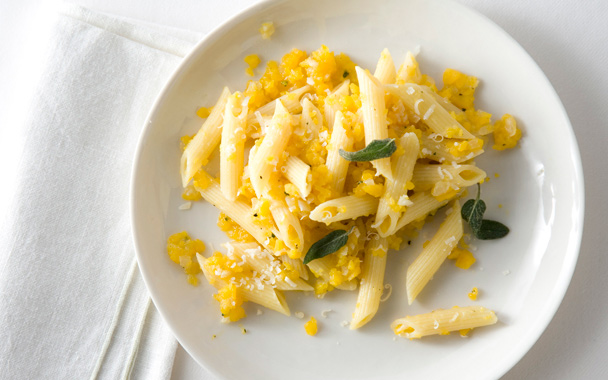Pet peeves: We’ve all got them in the kitchen. Dealing with butternut squash is one of mine. Removing the skin is such a chore that I let the squash sit idle too long on my counter or skip buying it altogether. I realize I’m not alone in my aversion. Piled primly in the produce section these days are plastic boxes of already peeled and seeded chunks of butternut, naked without their thick beige overcoats. Seeing them ignites a minor war between the harried Working Mother me and the idealistic, do-it-yourself Earth Mother me.
“Go on, buy the chunks and make your life easier,” says Working Mom. “Don’t be a fool,” replies Earth Mother. “You don’t know how long that squash has been without its skin. It’s probably dried out and has lost all its goodness. Buy it whole.” Earth Mother is in full gear on Saturday mornings and generally wins. It’s the whole squash that comes home. By Monday evening, though, Working Mom has pushed it aside.
Determined not to let yet another butternut rot, I plunk one on my cutting board. “Get over it,” says Earth Mother, exasperatedly. “Of all the winter squashes it’s the easiest to peel. No ridges.”
“Yeah, but there’s that big bulbous bottom,” complains Working Mom. “It takes too long.”
And that’s when it hits me: I don’t have to tackle the whole squash right then. I swiftly lop off the rounded end where all the seeds hang out—I do adore them toasted and salted—and stick it in the fridge, wrapped up, for Earth Mother to wrestle with when she has more time. That leaves the long, solid neck, which is the easy part. To get the skin off, I forego a vegetable peeler—it requires too much hand contact with the clear, slippery substance the flesh emits—in favor of a chef’s knife. I cut the neck crosswise into thick rounds, then trim the skin off each slice in short, satisfying chops before cutting the flesh into cubes.
The whole process takes about five minutes tops, putting me that much closer to serving up the current family favorite, rotini tossed with a butternut squash sauce and topped with crisp-fried sage leaves. The sauce is basically a squash purée, and to get there quickly, Working Mom came up with another trick: Pile the cubed squash in the food processor, then let ’er rip until it’s ground into tiny pieces. Broken down like this, the squash simmers to tenderness in about the same time it takes to brown a chopped onion with some garlic—those two additions will add a savory balance to the sauce.
While the pasta boils, I fry the sage leaves. They are the crowning glory to this dish, so resist any temptation to skip them. In just a few seconds in hot oil, sage leaves go from leathery to shatteringly crisp, providing a very welcome texture—not to mention flavor—when piled on top. And therein lies the real secret to the food I feed my family: As long as there’s a little extra something for each member to add, by themselves, to personalize their serving, they’re very happy.




 Pinterest
Pinterest


